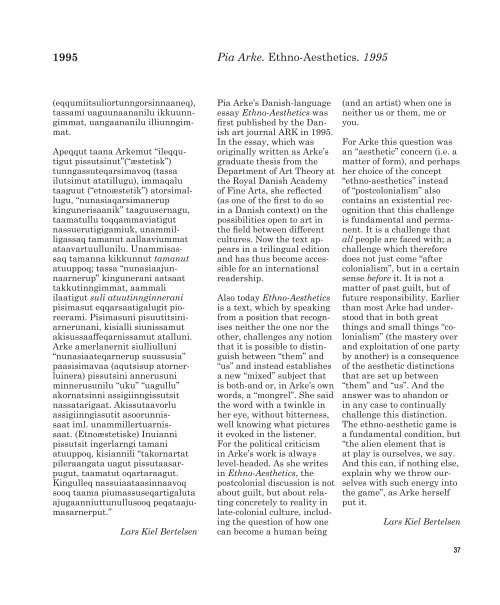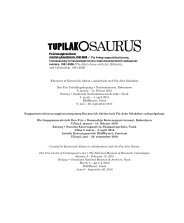tupilakosaurus - Print matters!
tupilakosaurus - Print matters!
tupilakosaurus - Print matters!
You also want an ePaper? Increase the reach of your titles
YUMPU automatically turns print PDFs into web optimized ePapers that Google loves.
1995<br />
(eqqumiitsuliortunngorsinnaaneq),<br />
tassami uaguunaananilu ikkuunngimmat,<br />
uangaananilu illiunngimmat.<br />
Apeqqut taana Arkemut “ileqqutigut<br />
pissutsinut”(“æstetisk”)<br />
tunngassuteqarsimavoq (tassa<br />
ilutsimut atatillugu), immaqalu<br />
taaguut (“etnoæstetik”) atorsimallugu,<br />
“nunasiaqarsimanerup<br />
kingunerisaanik” taaguusernagu,<br />
taamatullu toqqammaviatigut<br />
nassuerutigigamiuk, unammilligassaq<br />
tamanut aallaaviummat<br />
ataavartuullunilu. Unammisassaq<br />
tamanna kikkunnut tamanut<br />
atuuppoq; tassa “nunasiaajunnaarnerup”<br />
kingunerani aatsaat<br />
takkutinngimmat, aammali<br />
ilaatigut suli atuutinnginnerani<br />
pisimasut eqqarsaatigalugit pioreerami.<br />
Pisimasuni pisuutitsiniarnerunani,<br />
kisialli siunissamut<br />
akisussaaffeqarnissamut atalluni.<br />
Arke amerlanernit siulliulluni<br />
“nunasiaateqarnerup suussusia”<br />
paasisimavaa (aqutsisup atornerluinera)<br />
pissutsini annerusuni<br />
minnerusunilu “uku” “uagullu”<br />
akornatsinni assigiinngissutsit<br />
nassatarigaat. Akissutaavorlu<br />
assigiinngissutit asoorunnissaat<br />
iml. unammillertuarnissaat.<br />
(Etnoæstetiske) Inuianni<br />
pissutsit ingerlarngi tamani<br />
atuuppoq, kisiannili “takornartat<br />
pileraangata uagut pissutaasarpugut,<br />
taamatut oqartaraagut.<br />
Kingulleq nassuiaataasinnaavoq<br />
sooq taama piumassuseqartigaluta<br />
ajugaanniuttunullusooq peqataajumasarnerput.”<br />
Lars Kiel Bertelsen<br />
Pia Arke. Ethno-Aesthetics. 1995<br />
Pia Arke’s Danish-language<br />
essay Ethno-Aesthetics was<br />
first published by the Danish<br />
art journal ARK in 1995.<br />
In the essay, which was<br />
originally written as Arke’s<br />
graduate thesis from the<br />
Department of Art Theory at<br />
the Royal Danish Academy<br />
of Fine Arts, she reflected<br />
(as one of the first to do so<br />
in a Danish context) on the<br />
possibilities open to art in<br />
the field between different<br />
cultures. Now the text appears<br />
in a trilingual edition<br />
and has thus become accessible<br />
for an international<br />
readership.<br />
Also today Ethno-Aesthetics<br />
is a text, which by speaking<br />
from a position that recognises<br />
neither the one nor the<br />
other, challenges any notion<br />
that it is possible to distinguish<br />
between “them” and<br />
“us” and instead establishes<br />
a new “mixed” subject that<br />
is both-and or, in Arke’s own<br />
words, a “mongrel”. She said<br />
the word with a twinkle in<br />
her eye, without bitterness,<br />
well knowing what pictures<br />
it evoked in the listener.<br />
For the political criticism<br />
in Arke’s work is always<br />
level-headed. As she writes<br />
in Ethno-Aesthetics, the<br />
postcolonial discussion is not<br />
about guilt, but about relating<br />
concretely to reality in<br />
late-colonial culture, including<br />
the question of how one<br />
can become a human being<br />
(and an artist) when one is<br />
neither us or them, me or<br />
you.<br />
For Arke this question was<br />
an “aesthetic” concern (i.e. a<br />
matter of form), and perhaps<br />
her choice of the concept<br />
“ethno-aesthetics” instead<br />
of “postcolonialism” also<br />
contains an existential recognition<br />
that this challenge<br />
is fundamental and permanent.<br />
It is a challenge that<br />
all people are faced with; a<br />
challenge which therefore<br />
does not just come “after<br />
colonialism”, but in a certain<br />
sense before it. It is not a<br />
matter of past guilt, but of<br />
future responsibility. Earlier<br />
than most Arke had understood<br />
that in both great<br />
things and small things “colonialism”<br />
(the mastery over<br />
and exploitation of one party<br />
by another) is a consequence<br />
of the aesthetic distinctions<br />
that are set up between<br />
“them” and “us”. And the<br />
answer was to abandon or<br />
in any case to continually<br />
challenge this distinction.<br />
The ethno-aesthetic game is<br />
a fundamental condition, but<br />
“the alien element that is<br />
at play is ourselves, we say.<br />
And this can, if nothing else,<br />
explain why we throw ourselves<br />
with such energy into<br />
the game”, as Arke herself<br />
put it.<br />
Lars Kiel Bertelsen<br />
37




